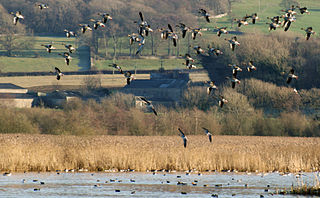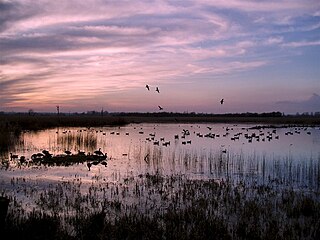
Blacktoft Sands RSPB reserve is a nature reserve in the East Riding of Yorkshire, England. [1] It is managed by the Royal Society for the Protection of Birds, which leases the site from Associated British Ports. [2]

Blacktoft Sands RSPB reserve is a nature reserve in the East Riding of Yorkshire, England. [1] It is managed by the Royal Society for the Protection of Birds, which leases the site from Associated British Ports. [2]
The site is on the southern bank of the Ouse, west of its confluence with the River Trent, opposite the village of Blacktoft, and is a wetland. Being at the beginning of the Humber Estuary, the water is slightly saline. [3] The reserve's tidal reedbed is the largest in England. It is managed using a mixture of grazing with our six konik horses, reed cutting and maintaining and excavation of pools within the reedbed. [1]
As an RSPB reserve Blacktoft Sands is known for its birdlife. The headline species are wetland birds which are rare in Britain. Breeding birds include Western marsh harrier, great bittern and bearded reedling which are reedbed specialists, while the pied avocet prefers the saline lagoons. Hen harrier is a notable wintering species, joining the previously mentioned species, along with merlin, peregrine falcon and barn owl. Large numbers of Eurasian teal and Eurasian wigeon also winter. [1] The great bitterns firs bred in 2000 and the pied avocets in 1992 and the Humber is now home to nationally important populations of these species. The Humber Estuary overall is important for breeding and wintering waders and wildfowl. [3] The site is also important for passage birds such as Eurasian spoonbill, spotted redshank and ruff. [1]
The lagoons are home to some rare specialist invertebrates including the amphipods Gammarus insensibilis and Gammarus chevreuxi, as well as the chironomid Glyptotendipes barbipes . [3]

Leighton Moss RSPB reserve is a nature reserve in Lancashire, England, which has been in the care of the Royal Society for the Protection of Birds since 1964. It is situated at Silverdale near Carnforth, on the edge of Morecambe Bay and in the Arnside and Silverdale Area of Outstanding Natural Beauty.

Strumpshaw Fen is a nature reserve managed by the Royal Society for the Protection of Birds (RSPB). It is situated at Strumpshaw on the River Yare in the English county of Norfolk around 6 miles (9.7 km) east of Norwich. The Buckenham Marshes RSPB reserve borders the reserve to the east.

Titchwell Marsh is an English nature reserve owned and managed by the Royal Society for the Protection of Birds (RSPB). Located on the north coast of the county of Norfolk, between the villages of Titchwell and Thornham, about 8 km (5.0 mi) east of the seaside resort of Hunstanton, its 171 hectares include reed beds, saltmarshes, a freshwater lagoon and sandy beach, with a small woodland area near the car park. This internationally important reserve is part of the North Norfolk Coast Site of Special Scientific Interest (SSSI) and the Norfolk Coast Area of Outstanding Natural Beauty (AONB), and is also protected through Natura 2000, Special Protection Area (SPA) and Ramsar listings.

The pied avocet is a large black and white wader in the avocet and stilt family, Recurvirostridae. They breed in temperate Europe and across the Palearctic to Central Asia then on to the Russian Far East. It is a migratory species and most winter in Africa or southern Asia. Some remain to winter in the mildest parts of their range, for example in southern Spain and southern England. The pied avocet is one of the species to which the Agreement on the Conservation of African-Eurasian Migratory Waterbirds (AEWA) applies.

RSPB Minsmere is a nature reserve owned and managed by the Royal Society for the Protection of Birds (RSPB) at Minsmere, Suffolk. The 1,000-hectare (2,500-acre) site has been managed by the RSPB since 1947 and covers areas of reed bed, lowland heath, acid grassland, wet grassland, woodland and shingle vegetation. It lies within the Suffolk Coast and Heaths Area of Outstanding Natural Beauty and the Suffolk Heritage Coast area. It is conserved as a Site of Special Scientific Interest, Special Area of Conservation, Special Protection Area and Ramsar site.

RSPB Dearne Valley Old Moor is an 89-hectare (220-acre) wetlands nature reserve in the Dearne Valley near Barnsley, South Yorkshire, run by the Royal Society for the Protection of Birds (RSPB). It lies on the junction of the A633 and A6195 roads and is bordered by the Trans Pennine Trail long-distance path. Following the end of coal mining locally, the Dearne Valley had become a derelict post-industrial area, and the removal of soil to cover an adjacent polluted site enabled the creation of the wetlands at Old Moor.

Trent Falls is the confluence of the River Ouse and the River Trent which forms the Humber between Lincolnshire and the East Riding of Yorkshire in England.

Burton Mere Wetlands is a nature reserve on the Dee Estuary straddling the border between Cheshire, England and Flintshire, Wales. It is run by the Royal Society for the Protection of Birds (RSPB) and incorporates the older Inner Marsh Farm reserve. It lies near the village of Burton, about 3 kilometres (1.9 mi) south of Neston. It has all been developed by the RSPB and includes a large area of mixed wetland habitats, bluebell woodlands, and arable fields all managed to attract wildlife.

Havergate Island is the only island in the county of Suffolk, England. It is found at the confluence of the River Ore and the Butley River near the village of Orford. It is a marshy nature reserve run by the Royal Society for the Protection of Birds (RSPB) and is known for its population of avocets and terns. It is part of the ecologically important Alde-Ore Estuary and has protected conservation status as part of a national nature reserve, SSSI, SAC, SPA, Ramsar Site and is also a part of the Suffolk Coast and Heaths AONB.

Oare Marshes is a 71.4-hectare (176-acre) Local Nature Reserve north of Faversham in Kent. It is owned and managed by Kent Wildlife Trust. It is part of The Swale Nature Conservation Review site, Grade I, National Nature Reserve, Ramsar internationally important wetland site, Special Protection Area under the European Union Directive on the Conservation of Wild Birds, and Site of Special Scientific Interest.

Tagus Estuary Natural Reserve is a natural reserve in Portugal. It is one of the 30 areas which are officially under protection in the country. The estuary of the Tagus River is the largest wetland in the country and one of the most important in Europe, a sanctuary for fish, molluscs, crustaceans, and especially to birds that stop-over on their migration between northern Europe and Africa. It is the largest estuary in western Europe, with about 34,000 hectares, and regularly hosts 50,000 wintering waterfowl

Newport Wetlands is a wildlife reserve covering parts of Uskmouth, Nash and Goldcliff, in the south-east of the city of Newport, South Wales.

Valley Wetlands, formerly Valley Lakes, is a nature reserve in Anglesey, Wales belonging to the Royal Society for the Protection of Birds. It is an area of lakes and reedbeds to the south-east of Valley in Llanfair-yn-Neubwll community, adjacent to RAF Valley airfield. The western section of the reserve includes Llyn Penrhyn, Llyn Treflesg and part of Llyn Dinam. The eastern part includes Llyn Traffwll and wetlands along the Afon Crigyll. Much of the reserve is included within two Sites of Special Scientific Interest.

Reedy Lake, historically also known as Lake Reedy, is a shallow 5.5-square-kilometre (2.1 sq mi) intermittent freshwater lake or swamp on the lower reaches of the Barwon River, on the Bellarine Peninsula southeast of Geelong in the Australian state of Victoria.

Marazion Marsh is a Royal Society for the Protection of Birds (RSPB) reserve situated in a shallow river valley, half a kilometre to the west of Marazion, Cornwall, UK. It is separated from the coast by a shingle bar and small sand dune system and contains Cornwall's largest reed bed.

Housing more than 200 resident and wintering bird species, Chennai has long been a haven for bird watchers. It is the one of the few urban areas in India with diverse range of birds including greater flamingo, black baza, osprey, Eurasian eagle-owl, malabar barbet, Spot billed pelican and pied avocet can be seen. The following are some known birding hotspots in and around Chennai.

Dingle Marshes is a 93 hectares wildlife reserve on the North Sea coast of the English county of Suffolk. The reserve is located between Dunwich and Walberswick, approximately 4 miles (6.4 km) south-west of Southwold. The marshes make up part of the Suffolk Coast National Nature Reserve along with reserves at Walberswick and Hen Reedbeds. They are owned jointly by the RSPB and Suffolk Wildlife Trust and are managed by these two organisations and Natural England. The site is in the Dunwich Heaths and Marshes Nature Conservation Review site, Grade I, the Minsmere-Walberswick Ramsar internationally important wetland site, the Minsmere to Walberswick Heaths and Marshes Special Area of Conservation, and the Minsmere-Walberswick Special Protection Area under the European Union Directive on the Conservation of Wild Birds.

Hen Reedbeds is a 55 hectare nature reserve near the North Sea coast of the English county of Suffolk. The reserve is located in the Blyth valley between Reydon and Blythburgh, approximately 2.5 miles (4.0 km) west of Southwold. The marshes make up part of the Suffolk Coast National Nature Reserve along with reserves at Walberswick and Dingle Marshes.

Cley Marshes is a 176-hectare (430-acre) nature reserve on the North Sea coast of England just outside the village of Cley next the Sea, Norfolk. A reserve since 1926, it is the oldest of the reserves belonging to the Norfolk Wildlife Trust (NWT), which is itself the oldest county Wildlife Trust in the United Kingdom. Cley Marshes protects an area of reed beds, freshwater marsh, pools and wet meadows and is part of the North Norfolk Coast Site of Special Scientific Interest (SSSI), Special Area of Conservation (SAC), Special Protection Area (SPA), and Ramsar Site due to the large numbers of birds it attracts.

Suffolk Coast National Nature Reserve is a wildlife reserve on the North Sea coast of the English county of Suffolk. It is located around the village of Walberswick to the south of the town of Southwold. The reserve was designated in 2003, combining the existing Walberswick National Nature Reserve with reserves at Dingle Marshes and Hen Reedbeds to create a 1,340 hectares reserve.